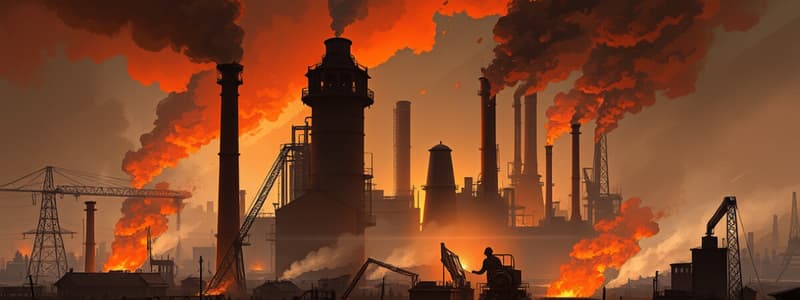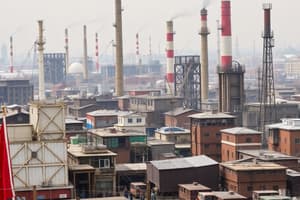Podcast
Questions and Answers
Which major sector experienced significant expansion during the late 19th century?
Which major sector experienced significant expansion during the late 19th century?
- Telecommunications
- Automobile manufacturing
- Steel (correct)
- Agriculture
What primary factor contributed to the urbanization of cities during this period?
What primary factor contributed to the urbanization of cities during this period?
- Massive immigration for job opportunities (correct)
- Better agricultural techniques
- Availability of transportation options
- Government housing initiatives
Which event was NOT associated with the labor movements of the late 19th century?
Which event was NOT associated with the labor movements of the late 19th century?
- Pullman Strike
- Homestead Strike
- Haymarket Affair
- Boston Tea Party (correct)
What was a common feature of the political landscape during the late 19th century?
What was a common feature of the political landscape during the late 19th century?
Which of the following acts aimed to regulate monopolies in the late 19th century?
Which of the following acts aimed to regulate monopolies in the late 19th century?
Who was a notable figure associated with the steel industry during this period?
Who was a notable figure associated with the steel industry during this period?
What social class notably rose during the period of economic growth and urbanization?
What social class notably rose during the period of economic growth and urbanization?
What cultural development characterized the arts and literature of the late 19th century?
What cultural development characterized the arts and literature of the late 19th century?
Which of the following was a notable labor union during the late 19th century?
Which of the following was a notable labor union during the late 19th century?
What was a notable leisure activity that emerged during this period?
What was a notable leisure activity that emerged during this period?
Flashcards are hidden until you start studying
Study Notes
Overview
- Period: Late 19th century, roughly 1870s to 1900.
- Characterized by rapid economic growth, industrialization, and urbanization in the United States.
Economic Growth
- Marked by significant industrial expansion, particularly in steel, railroads, and textiles.
- Rise of monopolies and trusts exemplified by figures like John D. Rockefeller (Standard Oil) and Andrew Carnegie (Carnegie Steel).
- Development of the financial sector, including the establishment of investment banks.
Social Changes
- Massive immigration, primarily from Europe, led to population growth in cities.
- Urbanization: Growth of cities as people moved for jobs; cities became centers of industry and culture.
- Rise of a distinct middle class, alongside a growing disparity between the wealthy elite and the poor.
Labor Movements
- Poor working conditions in factories led to the rise of labor unions (e.g., Knights of Labor, American Federation of Labor).
- Notable events: Haymarket Affair (1886), Homestead Strike (1892), Pullman Strike (1894).
- Demands included better wages, hours, and working conditions.
Political Landscape
- Corruption was rampant in politics, with practices like patronage and graft prevalent.
- Political machines, such as Tammany Hall in New York City, wielded significant power.
- The era saw the rise of populism, particularly among farmers and laborers seeking reforms.
Cultural Developments
- The period saw a flourishing of arts and literature, known as realism and naturalism.
- Notable writers include Mark Twain and Henry James.
- The emergence of leisure activities and consumer culture, including the rise of department stores and amusement parks.
Notable Legislation and Events
- Interstate Commerce Act (1887): First federal law regulating railroads.
- Sherman Antitrust Act (1890): Aimed at curbing monopolies, though initially ineffective.
- The election of 1896 marked a significant political realignment, with William McKinley representing industrial interests against William Jennings Bryan's populist platform.
Legacy
- The Gilded Age set the stage for progressive reforms in the early 20th century.
- Issues of wealth inequality and labor rights continue to resonate in contemporary discussions about economic policy.
Overview
- Late 19th century period spanned from the 1870s to 1900.
- Defined by rapid economic growth, marked by industrialization and urbanization in the United States.
Economic Growth
- Significant expansion of industries, particularly in steel, railroads, and textiles.
- Emergence of monopolies and trusts represented by John D. Rockefeller (Standard Oil) and Andrew Carnegie (Carnegie Steel).
- Establishment of investment banks, reflecting a developed financial sector contributing to economic growth.
Social Changes
- Massive influx of immigrants from Europe leading to increased urban population.
- Urbanization transformed cities into industrial and cultural hubs; people migrated seeking job opportunities.
- Growth of a distinct middle class and widening gap between wealthy elites and impoverished communities.
Labor Movements
- Poor factory working conditions prompted the formation of labor unions, including the Knights of Labor and the American Federation of Labor (AFL).
- Significant strikes included the Haymarket Affair (1886), Homestead Strike (1892), and Pullman Strike (1894), highlighting worker unrest.
- Labor unions demanded improved wages, reduced working hours, and better working conditions.
Political Landscape
- Political corruption was rampant, characterized by patronage and graft.
- Political machines, notably Tammany Hall in New York City, held considerable power over local politics.
- Rise of populism emerged, driven by farmers and laborers advocating for significant reforms.
Cultural Developments
- Flourishing arts and literature movements labeled realism and naturalism gained traction.
- Important literary figures included Mark Twain and Henry James, who explored social issues through their works.
- The emergence of leisure activities and a consumer culture, highlighted by the rise of department stores and amusement parks.
Notable Legislation and Events
- Interstate Commerce Act (1887) was the first federal law to regulate railroad operations.
- Sherman Antitrust Act (1890) aimed to combat monopolistic practices, though it initially proved ineffective.
- The election of 1896 marked a political shift with William McKinley advocating for industrial interests against William Jennings Bryan's populist agenda.
Legacy
- The Gilded Age established a foundation for progressive reforms in the early 20th century.
- Enduring issues of wealth inequality and labor rights continue to influence contemporary economic policy discussions.
Studying That Suits You
Use AI to generate personalized quizzes and flashcards to suit your learning preferences.





